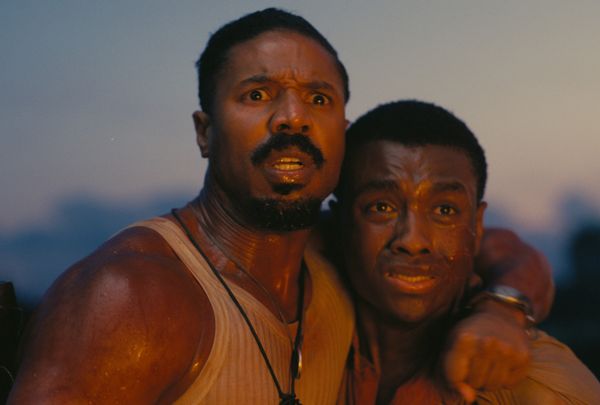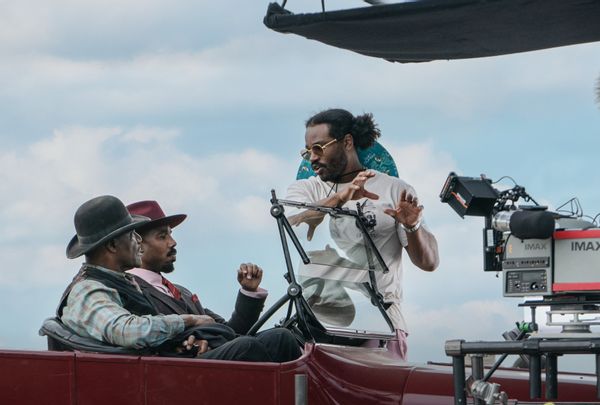The night before his 2013 debut feature “Fruitvale Station” hit theaters, director Ryan Coogler sat down for a wide-ranging talk hosted by Film at Lincoln Center. Early in their conversation, then-director of the New York nonprofit, Eugene Hernandez, asked Coogler how he felt on the eve of his first film opening nationwide. “I can’t really describe it,” Coogler began. He was effusive and wide-eyed, looking out into an audience hanging on his every word.
“I never imagined getting the opportunity to make it in the first place,” Coogler continued. “It was a miracle that we could even finish it. We were scrapping for money, scrapping for time. Once we [edited it], it was like, is anybody ever gonna see it? We just wanted to make something that people could sit down and … see a little bit of themselves in. From there, maybe that could lead to a thought process, whether they love it or whether they hate it.”
Industry journalism's direct and seemingly willful dissent from the larger cultural consensus surrounding “Sinners” only helps to keep power in the hands of those who already have it.
Coogler’s described experience isn’t uncommon for young, independent filmmakers. Once they battle 100 challenges, 100 more are just around the corner. Finishing the film at all is an achievement, let alone getting people to see it. And the great reviews “Fruitvale Station” received opened the door to a massive and exciting career for Coogler. Hernandez echoed this a moment later, adding, “For an indie film like this, the first weekend’s crucial. It means a lot to this movie, this kind of movie, these stories being told.”
In the nearly 12 years since that night, Coogler’s career has become the kind of success story young filmmakers dream about. He was tapped to helm “Creed,” the first of the spinoff films from the “Rocky” series, and soon after came Marvel’s “Black Panther” films, some of the studio’s best and most memorable entries in their exhaustive cinematic universe. Coogler — a Black director from Oakland, California, who was originally going to pursue medicine before a college professor pointed him toward screenplay writing — fought for his success. But beyond the director’s self-described scrappiness, it’s also Coogler’s innate eye for visual storytelling and emotional intensity that audiences have responded to. In that case, it’s no surprise that “Sinners,” Coogler’s first entirely original film, would pique viewers’ curiosity.
But “Sinners” has done more than ignite interest. In the days since its April 18 release, the film has become a massive box office achievement, one worthy of Coogler’s own success story. Stellar reviews and consistent word of mouth praise have sold out screenings days in advance, and the conversation surrounding the movie itself is on the tip of everyone’s tongue. “Sinners” is exactly the kind of dialogue-starter that Coogler hoped for on the eve of his first film debut: an entirely original movie that has put people in theater seats and shattered records in an age of never-ending remakes and reboots. By all metrics, “Sinners” is an industry-shaking triumph. So why are all the entertainment industry trades putting an asterisk on its success?
 (L to r) Michael B. Jordan and director Ryan Coogler behind the scenes of "Sinners" (Eli Adé/Warner Bros. Pictures)At the end of the film’s opening weekend, during which it earned an incredible $61 million worldwide, Variety’s box office summary concluded, “It’s a great result for an original, R-rated horror film, yet the Warner Bros. release has a $90 million price tag before global marketing expenses, so profitability remains a ways away.” Other responses, like the ones from the New York Times and Business Insider, had a similarly demeaning slant. While box office numbers were once considered industry jargon, the growth of social media and expanding brands like Variety, the Hollywood Reporter and Deadline into go-to publications for cinephiles and everyday readers alike means that reports like the ones put out for “Sinners” have the potential to impact a film’s success. Though “Sinners” is far from the determined indie film that “Fruitvale Station” was, trades are responding to Coogler’s latest as though the opening weekend is a make-or-break moment for the film. That narrative is just the latest in an unnerving trend that has seen leading sources of entertainment journalism pivoting toward conservative viewpoints and industry gatekeeping. And this direct and seemingly willful dissent from the larger cultural consensus only helps to keep power in the hands of those who already have it.
(L to r) Michael B. Jordan and director Ryan Coogler behind the scenes of "Sinners" (Eli Adé/Warner Bros. Pictures)At the end of the film’s opening weekend, during which it earned an incredible $61 million worldwide, Variety’s box office summary concluded, “It’s a great result for an original, R-rated horror film, yet the Warner Bros. release has a $90 million price tag before global marketing expenses, so profitability remains a ways away.” Other responses, like the ones from the New York Times and Business Insider, had a similarly demeaning slant. While box office numbers were once considered industry jargon, the growth of social media and expanding brands like Variety, the Hollywood Reporter and Deadline into go-to publications for cinephiles and everyday readers alike means that reports like the ones put out for “Sinners” have the potential to impact a film’s success. Though “Sinners” is far from the determined indie film that “Fruitvale Station” was, trades are responding to Coogler’s latest as though the opening weekend is a make-or-break moment for the film. That narrative is just the latest in an unnerving trend that has seen leading sources of entertainment journalism pivoting toward conservative viewpoints and industry gatekeeping. And this direct and seemingly willful dissent from the larger cultural consensus only helps to keep power in the hands of those who already have it.
Want a daily wrap-up of all the news and commentary Salon has to offer? Subscribe to our morning newsletter, Crash Course.
Just last week, I wrote about a rarity in the current movie market: A remake of “The Wedding Banquet” that brought interesting, new ideas and resonance to a familiar story. But the likelihood of a remake, reboot or sequel with any lingering value is slim. Moviegoers — especially ones who don’t live in major metropolitan areas — have little originality to choose from at the theater, which is why “Sinners” felt even more like a godsend from the cinema heavens. The film is conceived entirely by Coogler. It’s not an adaptation of any kind or yanked from a true story, and not a sequel to any existing film. What’s more, “Sinners” is a biting piece of blockbuster horror, co-produced and distributed by a major Hollywood studio.
It may feel bleak, but “Sinners” was a leap of faith for Warner Bros. that paid off immensely. To put the achievement into perspective, Warner Bros. has only co-produced and distributed an entirely original, non-biographical film that wasn’t a sequel to an existing property or simultaneously plopped onto streaming, three times in the last five years. Of the three, which include Clint Eastwood’s “Juror #2” and Christopher Nolan’s “Tenet,” Coogler’s film is the only one written and directed by a Black filmmaker.
 Smoke (Michael B. Jordan) and Sammie (Miles Caton) in "Sinners" (Courtesy Warner Bros. Pictures). In the dearth of ceaseless sequel-itis, that is major, and audiences took note. Viewers are as amped about the film being an original piece of work as they are about the movie itself. And after such a successful opening weekend, it’s no major surprise that the excerpt from the Variety write-up was received like a buzzkill showing up to a rager-in-progress. The post drew the ire of social media users and even an industry titan like Ben Stiller, whose criticism of Variety’s framing stunted the number of likes on the publication’s original post. But Variety wasn’t alone in their pointedly worded coverage; the New York Times said that the numbers included “a big asterisk.” Meanwhile, the contents of both the Times and Variety’s pieces admitted that “Sinners” is on track to recoup its $90 million price tag and then some. And besides that, a $61 million opening for an entirely original horror film boasting an R-rating is unheard of, especially in 2025.
Smoke (Michael B. Jordan) and Sammie (Miles Caton) in "Sinners" (Courtesy Warner Bros. Pictures). In the dearth of ceaseless sequel-itis, that is major, and audiences took note. Viewers are as amped about the film being an original piece of work as they are about the movie itself. And after such a successful opening weekend, it’s no major surprise that the excerpt from the Variety write-up was received like a buzzkill showing up to a rager-in-progress. The post drew the ire of social media users and even an industry titan like Ben Stiller, whose criticism of Variety’s framing stunted the number of likes on the publication’s original post. But Variety wasn’t alone in their pointedly worded coverage; the New York Times said that the numbers included “a big asterisk.” Meanwhile, the contents of both the Times and Variety’s pieces admitted that “Sinners” is on track to recoup its $90 million price tag and then some. And besides that, a $61 million opening for an entirely original horror film boasting an R-rating is unheard of, especially in 2025.
So why frame these responses as a raised eyebrow instead of a celebration over the state of cinema? That’s where things become both intriguing and alarming. In an enlightening guest post for the newsletter Contraband Camp, critic Brooke Obie states that the reaction is just another instance of Hollywood changing the standards of success for Black cinema. “White media has always conspired to spin the narrative and move the goalposts about Black films, Black filmmakers and their successes,” Obie writes. She also references another unique element of the “Sinners” story: a deal carved out by Coogler that will allow him to own the rights to the movie after 25 years, an extremely unconventional industry practice. When a similar deal was cut with Quentin Tarantino for 2019’s “Once Upon a Time in Hollywood,” the headline from the Hollywood Reporter touted it as a “score” for the director. In an illuminating comparison, the Times’ box office report for “Once Upon a Time in Hollywood” called that film’s opening weekend numbers a “hit,” while Coogler’s was met with doubt. But if you assess the numbers, Tarantino’s film actually made less money stateside than Coogler’s did during opening weekend. Yet it was “Sinners” that got slapped with an asterisk.
But this trend goes beyond just “Sinners,” extending to major entertainment news coverage from other outlets and trades, too, particularly when the topic could present a major shift in the entertainment industry. On the day “Sinners” was released, Vulture ran a piece detailing why Coogler’s deal with Warner Bros. was “scaring” studio executives. An anonymous source said that Coogler regaining the rights to “Sinners” after 25 years sets a “very dangerous” precedent that could topple the studio system as we know it. It stands to reason that, if studio execs are freaked out about the deal, the trade publications that function partially as an arm of Hollywood’s most powerful players would cover the indisputable success of “Sinners” with an apprehensive tone. Twelve years out from “Fruitvale Station,” with two major franchises under his belt and a surefire hit of an original film raking in the dough, Coogler’s story beckons other young filmmakers to try their hand at shaking up an industry set in its safe, risk-averse, white ways. Again, we can see that this isn’t just about money; it’s about power and who has it.
 (L to r) Delroy Lindo, Michael B. Jordan and director Ryan Coogler behind the scenes of "Sinners" (Courtesy Warner Bros. Pictures). Looking back over the last two months, we can track how that unease went from a simmer to a boil. In February, shortly after pop wunderkind Chappell Roan used her Grammy acceptance speech to demand record labels pay their artists a livable wage and give them better healthcare, the Hollywood Reporter published an inflammatory op-ed by a former label exec. The piece talked down to Roan and diminished her requests as childish and unthinking — ironic for something as petulant as the column reads. The piece garnered an immediate and intense reaction on social media, along with a response from Roan and artists like Charli XCX and Sabrina Carpenter matching Roan’s contribution to Backline’s “We Got You” campaign.
(L to r) Delroy Lindo, Michael B. Jordan and director Ryan Coogler behind the scenes of "Sinners" (Courtesy Warner Bros. Pictures). Looking back over the last two months, we can track how that unease went from a simmer to a boil. In February, shortly after pop wunderkind Chappell Roan used her Grammy acceptance speech to demand record labels pay their artists a livable wage and give them better healthcare, the Hollywood Reporter published an inflammatory op-ed by a former label exec. The piece talked down to Roan and diminished her requests as childish and unthinking — ironic for something as petulant as the column reads. The piece garnered an immediate and intense reaction on social media, along with a response from Roan and artists like Charli XCX and Sabrina Carpenter matching Roan’s contribution to Backline’s “We Got You” campaign.
These publications disseminate narratives into the entertainment world. Even if the average person didn’t see a headline from Variety, Deadline or the Hollywood Reporter, how they write about films and artists affects where the money goes. If a bold, original film like “Sinners” has its success met with doubt, it could easily result in fewer original ideas being funded.
A similar instance occurred in March, when Variety published an article detailing the “Snow White” remake’s rocky road to theaters. The piece specifically mentioned the film’s star, Rachel Zegler, and her candid pro-Palestine posts on social media, which led to producer Marc Platt flying to New York to meet with Zegler, who stood her ground. While Zegler and Disney declined to comment for the piece, the article quotes an anonymous insider who blamed the movie’s poor box office returns on Zegler. “She didn’t understand the repercussions of her actions,” the insider said. There was, unsurprisingly, no insider quote that examined Zegler’s side of the story, and the imbalanced perspective once again caught the eye of social media users when Variety posted an excerpt from the article on X. “Did you post this thinking it would make us like her less?” one user asked. Another notable comment came from “Scream” star Melissa Barrera, who pointed out that she, too, had been criticized by Variety for her shared political views.
Coogler, Roan and Zegler all have three glaring, important things in common: They all belong to marginalized communities; they all achieved their success from the ground up; and they all have stood defiant in the face of a machine much larger and more powerful than they are alone. While it’s not a full-scale political rebellion, their opposition is nothing to scoff at. These artists want to own their work, be paid a living wage, have access to decent healthcare and express their views with impunity, as is their right. But those things conflict with the agendas of some entertainment journalism publications. Trades aren’t known to be unbiased sources of information, but that doesn’t account for all those who may read these pieces and take them at face value. We no longer live in a time when Variety and the Hollywood Reporter are read solely by those within the entertainment industry. Now, these pieces are picked up by your mom, dog walker and bank teller. Their articles affect how the common person spends their money, and the trades have a vested interest in protecting the status quo because that’s the safest (and whitest) way to keep the cash coming in. Of course, an original idea from a free-thinker makes them shake in their boots.
We need your help to stay independent
These publications are, after all, how narratives are disseminated into the world of entertainment. Even if the average person didn’t see a headline from Variety, Deadline or the Hollywood Reporter, how these publications write about films and artists affects where the money goes. If a bold, original film like “Sinners” has its success met with doubt, it could result in fewer original ideas being funded.
Putting an asterisk on something as monumental as “Sinners” doesn’t just denigrate the film to potentially impressionable readers, it serves Hollywood executives looking to make films referred to in board meetings as “content,” or watched in the background at home. Framing the success of “Sinners” like this opens the door for companies like Netflix to slip in and make sure that the format they’ve put billions of dollars into — the home streaming model, where most of the original content is forgotten in a week — isn’t dismissed by the viewer. Slanting the dialogue of a major theatrical gangbuster toward hesitation or negativity only feeds the slop machine.
And right on cue, with “Sinners” in its second weekend dominating the box office with sold-out screenings, is a Deadline article detailing Netflix CEO Ted Sarandos saying the theatrical experience is outmoded. Sarandos is quoted in the piece asking, “What is the consumer trying to tell us? That they’d like to watch movies at home.” Next time you read an article in a trade that has nothing to do with the quality of the art itself, and everything to do with the artist or how they achieved their success, consider: “What is the publication trying to tell me?”
Read more
about Ryan Coogler's journey to "Sinners"



Shares